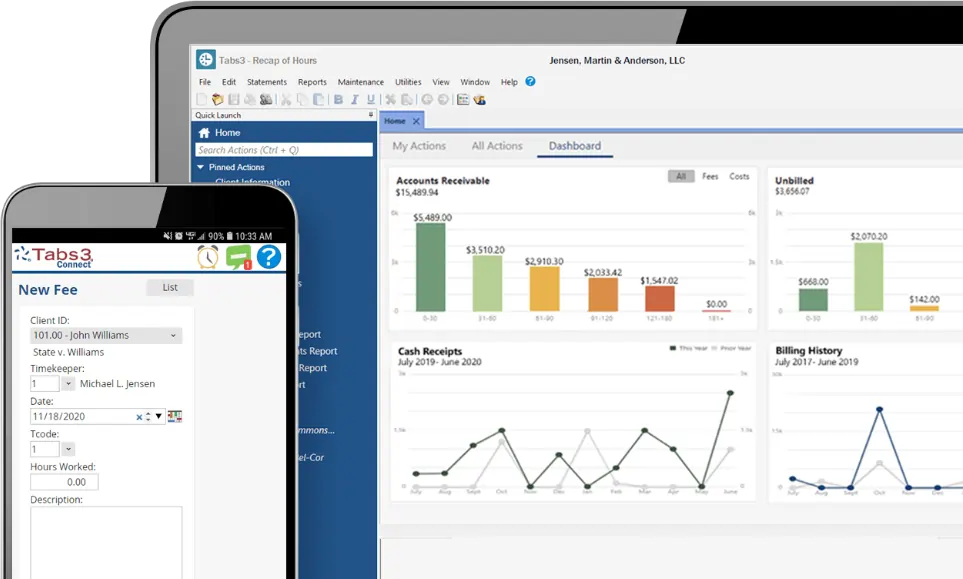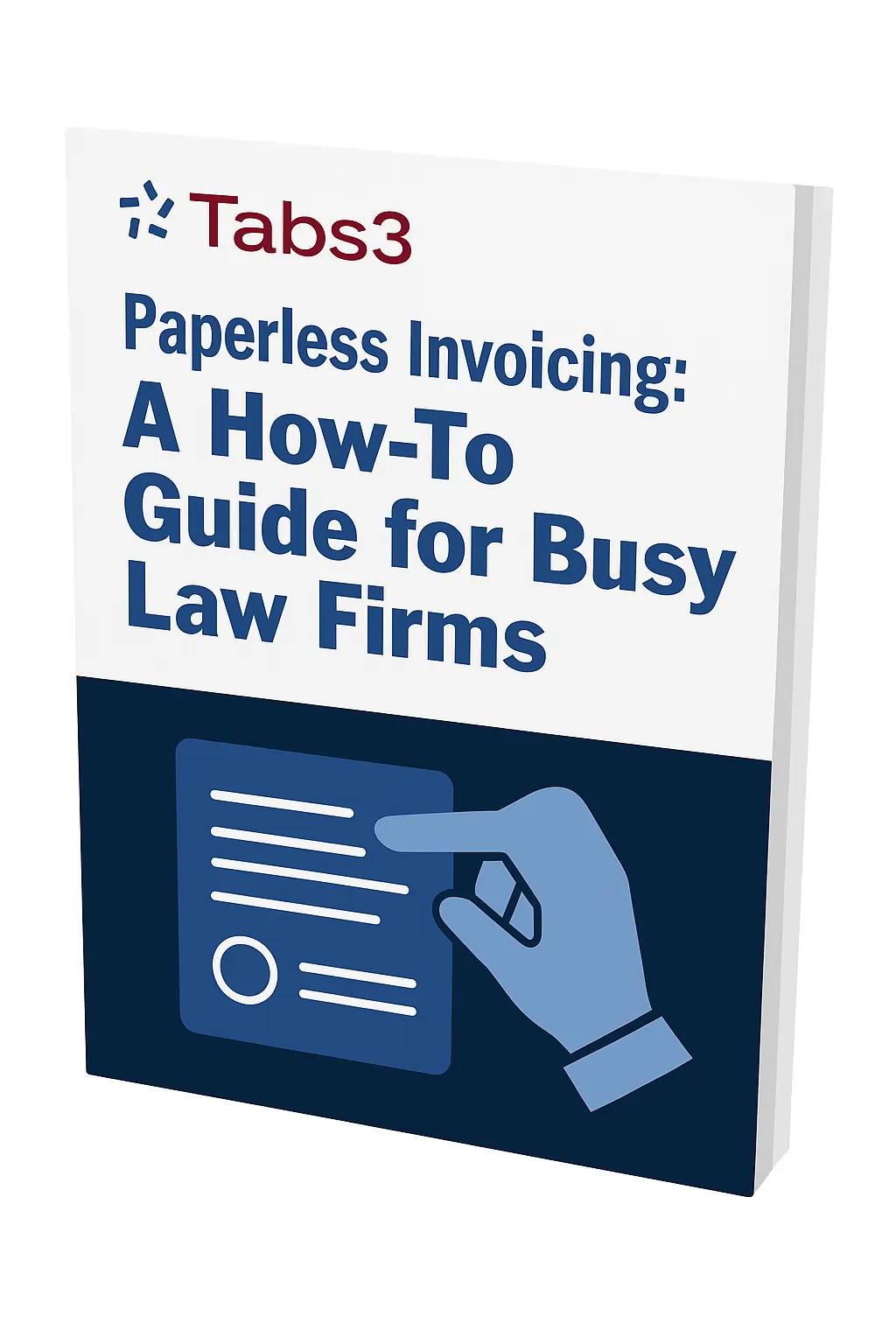
A professional law firm website is one of the most effective tools to attract new clients. With virtually unlimited reach as thousands of clients search online for law firms nearby, your website is the best way to instantly showcase your expertise and make a powerful first impression that ends in a signed contract.
More website visitors become clients when six key features are built into your website’s framework. From maximizing your search engine visibility to demonstrating clear social proof with reviews and testimonials, law firm websites with the following elements can help you enhance your site’s performance, increase conversions, and build a stronger client pipeline for long-term firm growth.
👉 Looking for a low-stress website solution? Watch 5 Reasons Law Firms Need Tabs3 Websites now to uncover what makes a turnkey website a competitive advantage for firms of all sizes.
The Benefits of a Professional Legal Website
Too many law firms see their website as a static digital business card. In truth, your website should be a dynamic part of your marketing strategy that is able to consistently attract, capture, and convert clients.
A well-executed law firm website can deliver numerous benefits. With the right site features guiding leads and prospects through the client journey, your firm can expect:
- Enhanced visibility and reach to help ideal clients find your firm and take the next step.
- More consultation requests with clear calls to action (CTAs) driving form fills and calls.
- Free organic traffic and leads from higher positioning in local law firm search results.
- Stronger credibility and trust through professional design and social proof elements.
- Simple, effective marketing that automatically attracts and captures qualified leads.
- Higher conversion rates by optimizing the user experience with clear guidance.
- A powerful first impression that showcases your firm’s services and expertise from the first click.
When 96% of legal clients begin their lawyer search online and 74% of searches end with a phone call, a strong website designed to increase online visibility is a key driver of client acquisition. Simple, optimized features can elevate basic law firm websites to high-performance engines that generate steady growth.
👉 Top-performing legal websites feature specific elements that drive results. Download Essential Elements of a Successful Law Firm Website now to learn what your website needs to reach its full potential.
6 High-Converting Law Firm Website Features That Win Clients
Like any marketing tool, law firm websites should be optimized and improved over time to enhance their lead generation capabilities. Ensuring key features and high-impact site elements are in place can strengthen your digital marketing strategy and enable your firm to drive more consultations, conversions, and long-term growth.
1. Client-Centric Features That Attract and Capture Leads
If your website is filled with legal jargon and focuses more on your credentials than your clients’ needs, it won’t appeal to prospective clients. Your website content should address the real-world challenges and legal questions your clients face on a daily basis. Visitors need to know you understand their situation and have the expertise to guide them before they submit a form or call your firm.
Today’s clients expect more than just information. They want the ability to take action: pay invoices online, check the status of their case, and securely communicate with their attorney. Your firm can support these expectations with seamless integrations with billing and CRM tools for client convenience.
- Post client-focused content that addresses common pain points and legal questions.
- Show visitors you understand their challenges and how you solve their problems.
- Use clear, consistent messaging and pair it with relevant visuals to engage and build trust.
- Offer practical features like online payments, client communication tools, and case updates to turn visitors into clients.
Focus on the outcomes your clients care about, speak their language, and ensure your website delivers more than information to provide real value for clients.
2. Fast, Mobile-Friendly Experience
A website that takes too long to load or fails to display properly on mobile devices is off-putting and challenging for users. As your firm’s digital first impression, your website should be optimized for speed and feature adaptable, mobile-first design.
When over 60% of searches happen on mobile devices and 40% of users leave sites that take more than 3 seconds to load, the importance of a fast-loading website that instantly adapts to fit mobile screens can’t be overstated.
- Conduct website and page load speed tests to understand where improvements are needed.
- Compress images and choose fast hosting to reduce loading time and bounce rates.
- Ensure navigation menus, buttons, and content display properly on various screen sizes.
Take the user experience a step further by ensuring your site is accessible for all users, including those with disabilities. Prioritize a clean, easily navigable design and straightforward information access.
3. Local Search Engine Optimization (SEO)
It’s incredibly difficult to rank in search results for broad, high-competition terms like “family lawyer,” and users searching for terms like those could be located anywhere in the United States. Instead, successful law firm websites use low-competition, location-based keywords to reach the clients searching for attorneys nearby.
Firms that prioritize local SEO are able to connect with high-intent prospective clients using search terms like “personal injury lawyer near me” or “Boca Raton divorce attorney.” Preparing your website with the right keywords and settings will enable you to reach these users early in their attorney search and generate more qualified leads in your area.
- Develop a strong local SEO strategy targeting your geographic area and relevant keywords.
- Identify the neighborhoods and regions you serve and local legal issues people search for.
- Claim and verify your Google Business Profile and other directories to enhance local visibility.
- Target local leads with Tabs3 Google Ads services to increase clicks, calls, and clients with proven ad strategies that position you at the top of local search results.
Potential clients often click the firm they see first in search results. Implementing a strong local search optimization strategy is a powerful way to increase site traffic from high-intent leads who are ready to convert.
4. Clear and Current Contact Information
Is it hard for leads to get in touch with your firm? If visitors can’t easily find your phone number, email, or office location, it’s harder for prospects to reach out. Easily accessible contact information is essential, yet many law firm websites bury details or complicate the process
Is your current website meeting your needs? From your website’s design to user experience and security, there are many factors that go into providing the best digital experience for anyone who visits your site. Running regular website audits is critical to ensure your site is reaching its performance potential.
5. Highlight Client Testimonials and Social Proof
Credibility markers and social proof help law firms win clients. Without testimonials, case results, or reviews displayed prominently on your website, potential clients have little reason to trust you over competitors. Studies show 80% of legal clients seek out online reviews and testimonials before hiring a lawyer. These elements build your reputation and differentiate your firm when leads visit your site.
- Showcase testimonials, reviews, awards, and case studies throughout your website to build trust and demonstrate results.
- Use specialized tools like Feedback Automatic to display positive reviews on your website and keep negative comments internal.
- Create dedicated landing pages for each practice area with relevant testimonials and results to show qualified leads how you can assist with their specific legal needs.
Ensure testimonials feel authentic and specific. Feedback that goes beyond generic praise is most effective. For example, “John helped me get my life back after my accident” resonates with similar clients. Highlight your firm’s success and team expertise with concrete examples to build trust and approachability.
6. Built-In Engagement Tools
High-converting legal websites do more than inform; they engage and prompt users to explore further or take the next step. Many firm websites function as static brochures rather than dynamic lead generation and client relationship tools. Implementing the right features can help you engage visitors consistently to drive more conversions.
- Follow up on form submissions quickly and create multiple touchpoints before clients decide.
- Create a sales funnel to guide visitors to book a free consultation. Consider offering free tools or guides to build trust and nurture leads with email drip campaigns.
- Measure your website and marketing ROI data to ensure strategies deliver increasing value.
As your firm grows, evolve engagement strategies to handle more leads and client needs. Use your website to start conversations, not just display credentials. Embrace content marketing with helpful resources that build expertise and value.
👉 Want to see how easy it is to launch a high-converting website that works as hard as you do? Schedule a demo to explore Tabs3 Websites now.
An Easier Path to a High-Performance Law Firm Website
The six features above are essential building blocks of a law firm website that attracts and converts new clients. Miss even one and you could risk losing leads, weakening your first impression. Solve your prospecting and client service needs with a site developed by specialists in the legal industry: Tabs3 Websites.
Sites from Tabs3 Websites are backed by years of legal marketing expertise and designed to help your firm look sharper, move faster, and grow smarter. Give clients what they expect from a modern firm: the ability to pay online, get in touch easily, and track their case status securely. From lead capture to payment processing, it’s all built in.
When you launch your new website, you get everything you need to succeed online:
- Professional, modern design
- 10 customizable webpages
- Built-in legal SEO content and FAQs
- Industry-leading security and compliance features
- Done-for-you design, support, and maintenance
- Seamless integration with Tabs3Pay and Tabs3 CRM
- Add-ons like client reviews and Google Ads services
Tabs3 Websites are fast, secure, and purpose-built for the legal industry. Ready to launch a website that reflects the professionalism of your practice? Schedule a demo today and discover your shortcut to a stronger online presence.
👉 Want to see how easy it is to launch a high-converting website that works as hard as you do? Schedule a demo to explore Tabs3 Websites now.
Ready to transform your law firm’s billing process? Schedule a personalized demo and discover how Tabs3 Cloud can transform your firm in one complete practice management solution.

We know that invoicing keeps the lights on. For many small and midsize firms, however, the billing cycle eats up too much attorney time and stretches administrative teams too thin. Going paperless, with the right technology and workflows, can bring billing back into balance.
Tabs3 products are built for law firms like yours. When using Tabs3 Billing, Tabs3 Financials, Tabs3Pay and Tabs3 Cloud, you can reduce or eliminate paper while reducing workload for attorneys and professional staff.
What is paperless billing?
Paperless billing means leveraging electronic recordkeeping and automation to reduce or eliminate paper-based work. Going paperless is good for the planet, your pocketbook, and your workload.
Paper-free processes can speed up time entry, eliminate duplicative work, reduce the chance of statement errors, and streamline collections. You can also reduce the paper needed for trust account compliance and general accounting tasks.
The following sections describe the five steps of a paperless billing cycle.
Step 1: Generate draft statements electronically
Attorneys in firms without modern billing software tend to get stuck doing time entry via hard-to-use programs, spreadsheets, or handwritten notes. Billing clerks translate the time entries to draft statements via manual data entry.
The process creates problems. Generating draft statements takes too long, which ripples out across the firm, because billing clerks are less available for other support tasks. It is easy to misread a time entry or introduce a typo. Fixing errors costs billing clerk time (if the error is caught early) or attorney time (if the client finds the error). Delays compound; they slow the whole firm down and add unnecessary friction to everyone’s work.
The solution is an integrated, paper-free timekeeping and billing solution like Tabs3 Billing:
- Attorneys enter their time digitally via an interface built for their unique needs.
- On the back end, the billing clerk efficiently extracts the time entries.
- The software automatically translates the time entries into a draft statement. You can set up multiple templates in advance so no manual data entry is needed, even if you create statements in many different formats.
Step 2: Manage pre-billing digitally
The traditional statement approval, or pre-billing, process wastes time and paper too. The billing clerk prints draft statements, and stacks of paper are circulated among approving attorneys. Corrections are typically made by hand, introducing interpretation errors when the billing clerk types them in. There is also no central tracking of where each prebill is in the approval process.
Electronic pre-billing solves those problems while eliminating paper. With Tabs3 Billing:
- The billing clerk hands off the draft statement to the attorney by changing the statement’s status in the software. The approval process is tracked automatically, so authorized users can instantly see its status.
- The reviewing attorney gets a notification and opens a digital preview of the statement. They can type corrections or comments directly into the software. Then they mark the statement as reviewed.
- The billing clerk goes into the digital draft statement, resolves any outstanding issues, and finalizes it according to your firm’s procedures.
Once a process tied to printers and postal mail, digital tools now enable law firms to implement efficient, cost-effective paperless invoicing. Ready to make the switch? Take the first step toward a more organized and productive invoicing workflow. Download the guide today.
Step 3: Send paperless statements
Paper statements introduce costs and delays: postage, envelopes, printing, paper, and a process that cannot be fully automated. Even if you are unable to fully eliminate paper statements, you will likely find that some clients prefer electronic statements. Paper statements introduce costs and delays on their end as well.
Tabs3 Billing offers optional email statements, reducing paper and wasted time:
- Email statements consist of a short email with an attached statement in PDF format.
- You can create multiple templates for statement emails ahead of time. You have the option to personalize templates by inserting fields with a simple drag-and-drop interface.
- The fields pull in personalized information, like client name, balance due, and electronic payment links, and automatically insert it in the email’s subject line or body.
- When you set up email statements for a client, you choose an appropriate template.
- The billing clerk can send the approved statement with a single click. The software chooses the selected template, inserts the personalized information into the correct fields, generates a PDF statement, attaches the PDF, and sends the email.
Step 4: Collect payments electronically
In some practice areas, paper checks are the norm. Even in B2B transactions, however, electronic payment use is growing. Most consumers strongly prefer to pay electronically. Getting paid by check generates its own costs: on average receiving a paper check costs $1.01-$2.00, and check fraud is common.
Tabs3Pay integrates with Tabs3 Billing for faster, paper-free collections:
- You can include a live payment link in email statements.
- Clients can pay by ACH, debit card, credit card, PayPal, Venmo, or PayPal Pay Later. They never have to hunt for the checkbook or a stamp.
- The secure, PCI-compliant payment processor is built for law firms, so trust account compliance is baked in. Transactions automatically go into the correct account.
- Payments may be processed more quickly than paper checks.
- You may be able to manage the firm’s costs with surcharging. (Check state and local rules first, as they vary.)
👉 Set up a personalized demonstration with our experienced trainers today.
Step 5: Simplify compliance and recordkeeping
When your accounting processes are done on paper (or in a disconnected set of spreadsheets), it is easy to miss steps or get out of sync. Managing the recordkeeping burden of trust accounting without modern software increases the risk of errors, with the potential for serious business consequences. Paper-based three-way reconciliations are also time-consuming and error-prone.
Tabs3 Billing works with Tabs3 Financials to reduce paper and the risk of ethical breaches:
- Time entry, billing statements, accounts payable, and trust account management modules securely and automatically share the appropriate information.
- Your systems securely communicate with your financial institutions so you can keep a close eye on trust accounting.
- Three-way reconciliations are faster and more accurate with built-in reporting that automatically pulls in bank statements, your trust ledger, and each client’s individual trust ledger.
- By storing records electronically, you can reduce storage costs while making records more accessible to authorized users.
Cut out paper waste and wasted time with Tabs3
With Tabs3 Billing and Tabs3 Financials, available inTabs3 Cloud, you can create a virtually paper-free invoicing process. That works out to streamlined workflows, a faster revenue cycle, and happier clients. Schedule your free demo today.
👉 Paperless Invoicing: Why Your Law Firm Should Embrace the Digital Age
Ready to transform your law firm’s billing process? Schedule a personalized demo and discover how Tabs3 Cloud can transform your firm in one complete practice management solution.

Even when your phone is ringing off the hook, the people calling might not be the leads you need. Finding the right match requires qualifying leads fast and following up promptly with qualified prospects. That can create a major administrative burden and cut into billable time.
Tabs3 CRM can help. By automating aspects of your client relationships, you can sign more of the right clients with less work.
What is a CRM?
CRM stands for Client Relationship Management. A legal CRM can help your firm organize information, manage communication, and improve potential client relationships via centralized data storage and automation.
For example, a CRM might automate intake tasks like prescreening, consultation reminders, follow-ups, and engagement paperwork. CRMs can also boost intake collaboration within your office. They typically track all the contacts your office has with an individual, so anyone can see what has been done and which tasks remain.
Once a client has engaged your firm, a CRM that integrates with your practice management software can eliminate duplicative data entry.
CRMs help firms engage leads more efficiently
Managing relationships with leads begins the moment a potential client learns about your firm. The initial part of your intake workflow might look something like this:
Step 1: Be visible to potential clients
Many firms reach out to potential clients via multiple channels. For some, that means paid ads, like Google, Facebook, trade journals. For others, it might include bus benches and billboards. And no matter what your practice area is, a professional, engaging website is critical.
Tabs3 CRM can help you discover which channels are the most successful so you can iterate and improve your marketing. You can record lead sources or track them directly through an integration. For example, the software integrates with Tabs3 Websites, so website leads are automatically drawn into your intake workflow.
Step 2: Route inquiries appropriately
Whether you have dedicated intake staff or not, you need to get each lead to the right person at the right time. Tabs3 CRM can automatically route the leads to the right person, based on criteria you specify, or hold notifications when intake is unavailable. Routing inquiries correctly means fewer missed connections, so you can engage promising leads quickly.
Step 3: Pre-screen leads thoughtfully
A good pre-screening can save hours of wasted time. With Tabs3 CRM, you can create multiple digital intake forms for different types of cases or practice groups. Then you decide how to deploy them:
- Traditional phone screening, where you enter answers directly into the CRM. Screeners can initiate the call from Tabs3 CRM.
- Self-serve screening, where you send the lead a text or email with a link to the appropriate screening form. This allows you to make a preliminary representation decision before getting on the phone.
Once a process tied to printers and postal mail, digital tools now enable law firms to implement efficient, cost-effective paperless invoicing. Ready to make the switch? Take the first step toward a more organized and productive invoicing workflow. Download the guide today.
Nurture leads effectively
Leads that are qualified by pre-screening continue moving through the intake process. The latter part of an intake process typically includes these steps.
Step 1: Stay top of mind
Sometimes a qualified lead is not ready to move forward with their matter. But in a busy office, important follow-up tasks can fall through the cracks. With Tabs3 CRM automations, however, you can create set-it-and-forget-it follow-up sequences, like text reminders or a series of emails (a “drip campaign”).
Templates and an intuitive interface make it easy to create sequences with no prior experience. You can customize the words and timing to fit your firm’s style, so your messages feel natural and personalized, while freeing you up to concentrate on other matters.
The tool also includes dashboards and reports so you can see how people are responding to your messages.
Step 2: Simplify consultations
It takes time to prepare for a consultation, and missed appointments cut into work time for attorneys and professional staff alike. Reduce no-shows with Tabs3 CRM’s automated reminders, delivered by text or email. Reminders can include information about cancellation and no-show policies to encourage timely rescheduling.
Tabs3 CRM also offers a shared calendar and personalized task lists to help your office keep track of consultations and other intake events.
If you gathered documents prior to or during the consultation process, Tabs3 CRM can store them for you. Any authorized user in your firm can quickly access the documents when needed, and the materials can be transferred into Tabs3’s PracticeMaster if the lead engages your firm.
Step 3: Secure the engagement
If you want to represent the potential client, it is critical to get engagement letters and other representation paperwork out as soon as possible. Tabs3 CRM makes it simple to send forms and gather electronic signatures.
You can use the software to create customized engagement letters and fee agreements, using an interface that looks similar to Microsoft Word or Adobe Acrobat. Simply import your existing forms, and with a few tweaks, you can create a firm-specific library of options tailored to your practice areas and your firm’s policies.
When sending a letter to a potential client, you can select a form and initiate the e-signature process in seconds. The lead receives a secure link that allows them to read and sign the documents electronically, and the signed document is automatically returned to your office.
👉 Set up a personalized demonstration with our experienced trainers today.
Shift seamlessly from prospect to client
If you choose to represent the client, you can move the new client’s information into PracticeMaster in just a few clicks. That means less repetitive data entry and more time for billable tasks. Your intake workflow transitions gracefully into your new client workflow.
From first contact to conversion, streamline your intake workflow with Tabs3 CRM
All law practices struggle to balance client work with administrative tasks. You can take charge of your intake workflow with Tabs3 CRM:
- Screen leads quickly with custom intelligent forms
- Integrate Tabs3 CRM with a Tabs3 Website
- Automate marketing with time-saving tools and templates
- Follow up with precision to convert more clients
Our expert trainers are ready to show you exactly how your practice can benefit. Sign up for your personalized demo today.
Ready to transform your law firm’s billing process? Schedule a personalized demo and discover how Tabs3 Cloud can transform your firm in one complete practice management solution.

Your practice is busy. Staffing is lean. Clients expect speed. How does an overworked law office keep all the plates spinning? The right legal practice management software could make all the difference. Finding your fit could mean less administrative work—and better results.
This guide covers four reasons criminal defense firms can benefit from legal practice management software.
👉 Set up a personalized demonstration with our experienced trainers today.
What is law practice management software?
Legal practice management software helps you run your law firm. Unlike general-purpose business software, legal practice management software is designed just for law firms. For instance, it includes built-in tools to manage your trust accounts ethically and find potential conflicts before ethical issues arise.
Features vary among platforms, but legal practice management software usually offers some or all of the following:
- Time and billing (timers, time entries, invoicing, vendor payments)
- Financial management (bookkeeping and advanced financial tasks)
- Contact management for conflict checking and case management
- Case management (calendars, digital files, digital documents, workflow automations)
- Reporting and analytics to help you track your success
Some vendors combine features into a single product, while others create separate modules. Modular software allows you to choose the features you need based on your firm’s current needs and scale as you grow.
1. Stay compliant (and in the black)
Practice management software with robust financial features can reduce the time you spend managing the biggest keep-the-lights-on task: time and billing. The platform you choose should be simple and efficient, with strong guardrails around trust accounting and other compliance issues.
Criminal defense firms can get the following benefits.
Track your time effortlessly (even for flat-rate cases)
If your firm uses hourly rates, tracking time is crucial.
Even on flat fee matters, however, including time entries on account statements can help you manage your clients by showing the value of your work. And with accurate time data, you can check your flat rates against the actual time spent on cases and adjust future rates accordingly.
Look for time tracking products that fit your workstyle and caseload. For instance, you might appreciate a platform with a mobile app that allows you to track time when you are moving from depositions to court and back again. Apps allow you to write time entries on the go too, when your memory is freshest.
Some tools can flag common narrative mistakes as you write your entries, and have digital options for revising time entries during the billing statement approval process.
Get control of your cash flow
Staying on top of billing and collections can mean better collections rates. When generating statements is fast and easy, you are more likely to do it every month. Thus, good financial management software can help you collect more money in less time.
The best software for your practice is one that matches your firm’s unique needs. Consider your current statement approval workflow and how the software could speed up, automate, or otherwise improve that process, like:
- Accepting payments the way your clients want to pay (usually electronically).
- Reducing the number of steps it takes to generate, modify, and finalize invoices.
- Preventing unauthorized modification of time entries and invoices.
- Sending invoices by email or secure sharing link (if the client desires).
- Preventing trust/operating account mix-ups.
- Reporting on your collections rates so you can take action early.
If you use retainers or flat fees, look for software that can track retainer usage, make it simple for your clients to top up evergreen retainers, and send regular statements showing the work you have done on the client’s behalf.
Keep the bills paid and the books balanced
Your firm also has bills to pay, and financial software can save a great deal of time in accounts receivable. For example, you can automate recurring payments, pay electronically, see which invoices need to be paid, and manage 1099s.
If you handle bookkeeping in-house, a fully-featured financial management package can include general ledger as well trust accounting.
Once a process tied to printers and postal mail, digital tools now enable law firms to implement efficient, cost-effective paperless invoicing. Ready to make the switch? Take the first step toward a more organized and productive invoicing workflow. Download the guide today.
2. Build better relationships and avoid case conflicts
From intake to case resolution, managing client relationships (and finding conflicts early) is the name of the game.
Key wins for criminal defense practices include the following.
Find conflicts of interest faster
Even if you are a solo practitioner, your memory or a past client spreadsheet may not catch every potential conflict. Since any individual you come into contact with during a case could be a source of a conflict, the number of names you must record or remember is overwhelming.
Digital conflict checking can take the burden off you while increasing the accuracy of your conflict checks. A fully integrated practice management system can automatically search all your files, your emails, and your contact database. You can still do a memory-based cross-check, and you will make representation decisions with more confidence.
Put client information where the team can reach it
If your client and contact information is stored in multiple locations, a single synchronization error can become a headache. Centralized contact management allows everyone in the firm to see client contact details (as appropriate to their role) and ensures anyone who needs to contact a client has up-to-date information at their fingertips.
Speed up client communications
Sharing documents, getting signatures, and reminding clients about court dates and appointments can take up a lot of time. Many of those tasks can be automated with the right software.
For example, you may be able to:
- Send clients automatic text or email reminders about important events.
- Share documents quickly and securely without the risk of traditional email attachments.
- Gather legally binding eSignatures for engagement letters and other documents.
It is also important to retain client emails, both for your own case work and for future conflict checking efforts. Many contact management modules can integrate with your email.
Find your best-fit clients
Some contact management modules help you grow your firm by improving your marketing and intake processes. You might use the software to share intake data, automate potential client follow-up and reminders, and even collect pre-screening data to reduce the time spent doing intake for cases you cannot accept.
3. Get more organized and productive
If you are wasting hours every week managing paper files, disconnected calendars, and workflows full of repetitive manual tasks, practice management software can reduce your workload significantly. Many practice management systems include a case management module, which simplifies day-to-day client work.
Criminal defense firms often prioritize the following capabilities.
Never miss a deadline
When you are juggling filing deadlines, motion hearings, client conferences, and other court appearances, it can be difficult to keep the team in sync. Practice management platforms often include shared calendars to make coordination easier.
You can typically limit sharing to smaller groups. For instance, if a paralegal supports multiple attorneys, they can see both attorneys’ calendars, but neither attorney can see the other’s calendar. This keeps cluttered calendars cleaner and reduces mix-ups.
Eliminate repetitive manual tasks
In many criminal defense practices, everyone wears many hats. Any time you save on often-repeated tasks eases the workload. Reducing the need for double data entry is a common automation target.
That can take the form of data mapping, like a tool that moves potential client data from a CRM and into a case management module after the engagement letter is signed. Or it might mean digitizing the statement review process, so revisions are typed in instead of handwritten and then transcribed.
Instant access to the information you need
Centralizing and digitizing data storage keeps your team in sync and reduces the time spent looking for documents. Storing documents electronically minimizes the need for costly on-site document storage.
Digital access is even more powerful when you are away from the office. Software with a mobile app empowers you to review a file at home, look up a client’s address on the go, and search case documents while you are in court.
👉 Set up a personalized demonstration with our experienced trainers today.
4. Keep your eyes on the big picture
When workloads are intense, it is tempting to focus only on the work in front of you. That said, strong reporting and analytics tools can help keep your firm healthy—now and in the future. Practice management platforms usually come with built-in reporting capacity for most modules, and some offer advanced business intelligence and analytics.
Criminal defense firms can use reporting and analytics in the following ways:
Stay on top of short-term goals
Virtually every practice management platform comes with bread-and-butter reports like aging WIP (for time tracking and billing) and lead tracking (for CRMs). Regularly reviewing and taking action on reports is essential for every firm.
It is important to evaluate whether a platform’s built-in reporting meets your needs. Many law firms find they need at least a few custom reports, so you may wish to consider the availability of custom reporting (and what technical knowledge is needed to create reports).
Position for a successful future
Many firms can benefit from monthly, quarterly, or annual reviews of the firm’s progress towards long-term goals. That might include:
- Checking utilization and progress towards billing targets for each timekeeper.
- Analyzing the time spent on flat fee cases to determine whether rates need adjustment.
- Evaluating the progress of marketing efforts and then iterating with new ideas.
- Tracking financials to see where your dollars are going.
By choosing a practice management system that includes reports like this, you can spend less time reinventing the wheel. In some cases, you can get dynamic dashboards that visually represent close to real-time data.
Build a more prosperous criminal defense practice with Tabs3
Tabs3’s suite of legal practice management products was designed with you in mind. The platform is modular, so you can choose the features you need now and scale up as your practice grows. For example, you can:
- Make time tracking, billing, and retainer management effortless with Tabs3 Billing.
- Accept electronic payments with Tabs3Pay.
- Work wherever you choose with Tabs3Cloud.
- Manage bookkeeping, trust accounting, and pay bills with Tabs3 Financials.
- Get your team in sync and centralize document/client data storage with Tabs3 PracticeMaster.
- Get more clients in less time with Tabs3 CRM.
Want to learn more? Our legal practice management software experts are ready to listen to your needs and show you how Tabs3 can help. Schedule your demo today.
👉 Set up a personalized demonstration with our experienced trainers today.
Ready to transform your law firm’s billing process? Schedule a personalized demo and discover how Tabs3 Cloud can transform your firm in one complete practice management solution.

In Billing 101: Introduction to Billing Methods (Part 1), we discussed the terminology and structure behind hourly, contingency, and flat rate billing. But now that you have the invoice total, how do you plan to bill for it?
👉 Note: While this guide is software-agnostic, Tabs3 Billing users can get how-to information about each of these methods in the Billing Methods Guide.
There are multiple ways to bill for any fee structure
The fee structures above are about what the client owes the firm. The fee agreement also lays out when the client must pay and/or receive statements.
Billing/statement cadences vary
One-time billing is the simplest billing scenario. The client owes one all-inclusive fee, plus costs, minus discounts. The bill might be sent at the outset, at the end of the matter, or at another time.
Recurring periodic billing/statements can be used for any fee structure, including:
- A strictly hourly matter where all fees and costs are billed monthly.
- A flat fee paid in more than two or more installments.
- An ongoing flat fee engagement where the flat fee renews every month.
- Monthly information-only statements for a contingency case.
Threshold billing is waiting to bill until fees or costs reach a target amount. Instead of billing every month, you only bill when there is enough work-in-progress or expenses to meet the threshold. Your firm might also send information-only statements during cycles where the threshold is not reached.
Some bills are paid from a retainer
Sometimes you will send a bill to the client and wait for payment. Often, however, you can bill against a retainer.
A retainer is a lump sum payment to a firm.
- A security retainer is an advance payment on the client’s fees. It does not belong to the firm until the firm earns it, so it is held in the trust account. The client may need to replenish the retainer as fees are earned, or pay a recurring retainer.
- Clients can also pay a general retainer to reserve capacity at the law firm. It is considered earned right away, so it does not go into the trust account. The client must pay for the actual services separately.
The details of each retainer are set out in the fee agreement. There are ethical rules that govern how law firms handle retainers, so it is important to understand the exact terms of each retainer.
In the billing function, you might interact with retainers in several ways:
- Billing monthly for services completed, but paying the bill from the retainer instead of waiting for the client to send payment. The firm transfers money from the trust account into the operating account, and sends the client an informational statement.
- Asking the client to replenish their retainer balance, either periodically or when a certain threshold is reached.
- Refunding unearned retainer money to the client.
- Billing for a general retainer.
Some bills might be split among multiple entities
In some matters, you may need to apportion a bill among several groups. This can come up in transactional cases that involve multiple business units of a single company, or when a lawyer represents multiple clients on the same matter.
The fee agreement will lay out the details of the split. Both fees and costs can be split, and the percentages vary from case to case. You might also need to display nonbillable transactions on multiple invoices, or allocate credits among multiple clients.
Task-based billing uses codes to enable financial tracking
If your firm serves insurance companies or large corporations, you may need to do additional setup when opening a file. Sometimes this function is handled by a specialized e-billing clerk. When you add fee entries for task-based billing clients, you must include certain codes that describe the work done. This allows the client to track the fees and costs at a granular level. The bill is also submitted electronically.
Once a process tied to printers and postal mail, digital tools now enable law firms to implement efficient, cost-effective paperless invoicing. Ready to make the switch? Take the first step toward a more organized and productive invoicing workflow. Download the guide today.
Discounts, write-downs, write-ups, and write-offs impact totals
Reductions or increases in the bill are the last piece of the puzzle. Firms use a variety of words for these concepts, but the concepts themselves are the same across almost every firm.
- A discount means a reduction of the entire bill, usually by a percentage. Discounts can be one-time or recurring.
- A write-down means reducing the amount of time billed for a task, or removing certain time entries completely. Partners typically do this during statement review/pre-billing. It can also happen during collections, in which case you may need to create a revised statement. You may also be asked to run reports about write-downs, because consistent underbilling can undermine cash flow and reduce partner compensation.
- A write-up means increasing the amount billed beyond what is included in the work-in-progress. This might come up in contingency cases, where the firm is entitled to a certain percentage of a settlement even though it exceeds the amount the firm would have billed on an hourly case.
A write-off means forgiving an unpaid bill (or part of it). Write-offs have tax consequences, so deciding to write off debt is a strategic decision.
Questions to answer when setting up a new case
The following questions can help you get prepared to set up a new case. Depending on your firm, you might get this information from the fee agreement, from someone in your department, from the attorney, or some combination of those. You may want to add other questions that reflect your firm’s unique file-opening process.
For all matters. Detailed questions are in the following sections.
- Will the bills go to a single entity, or will they be split?
- Does this matter require task-based billing?
- Will we apply any thresholds for billing in this matter? If so, what are they?
For matters with retainers.
- Is this a security retainer that will be applied to fees and costs as they accrue? (If not, verify that it is a general retainer and should be placed in the operational account.)
- Is the retainer a one-time payment, or will the client need to replenish it? If so, when should the client replenish it?
- Will the client pay a retainer every month (or at some other cadence)? If so, is there a threshold at which we need to collect fees in another way, like hourly billing?
- What happens to the retainer at the conclusion of the matter (i.e., balance refunded or retained as earned fee)?
For matters with split billing.
- How will fees and costs be split?
- How will credits and nonbillables be split?
- How will advance fees or retainers be split?
- For fees, do you want to split the amount due (hours x rate), or split the hours and then apply rates to calculate the amount due?
Tabs3 makes every fee structure and billing methodology easier
If your firm is not using Tabs3 Billing yet, we would love to show you how easy even complex billing can be. The platform offers virtually unlimited billing options, with smart shortcuts to save you time. You can even handle the statement approval process entirely within Tabs3 Billing with our pre-billing feature.
👉 Set up a personalized demonstration with our experienced trainers today.
Ready to transform your law firm’s billing process? Schedule a personalized demo and discover how Tabs3 Billing simplifies invoicing, boosts security, and streamlines payments – all in one seamless platform.

If revenue is the lifeblood of a law firm, the billing function is its beating heart. Whether you specialize in billing or juggle many administrative duties, the questions you ask when opening a new file set the stage for successful billing and collections.
This guide offers a deep dive into definitions and fee structures. It wraps up with a list of questions to help you navigate any billing setup, no matter how complicated. Part 2 of this series will delve into how to bill for various fee structures.
Note: While this guide is software-agnostic, Tabs3 Billing users can get how-to information about each of these methods in the Billing Methods Guide.
An overview of billing terminology
Fee structures are broad categories of legal fees, like hourly, contingency, flat rate, or hybrids.
Fees compensate the firm for its legal work, like appearing in court or preparing a document. The most common fee structure is hourly. For an hourly matter, the fees are the number of hours each timekeeper worked, multiplied by the timekeeper’s rate.
Costs compensate the firm for its expenditures, like copying files or paying court filing fees. Costs are divided into expenses and advances. Expenses represent a portion of the firm’s overhead, like copying files on the firm’s photocopier. Advances are actual payments the firm makes on behalf of a client, like filing fees paid to the court.
Discounts reduce the bill. They can apply to the entire bill, or a partner might write down (not charge for) part of the fee.
Nearly every matter has a written fee agreement, which says how the fee will be calculated, who is responsible for costs, the billing cadence, and other agreements about representation. It may also be called an engagement letter, engagement agreement, fee contract, etc.
Depending on your firm’s size and file-opening process, you may get the actual fee agreement when you are setting up a new matter or only the information related to billing.
Fee structures can be simple or complex
The most common fee structures are hourly, contingency, and flat fee. But there are also hybrids that include any two of those fee structures, or even all three.
Hourly fee structure
Most transactional and defense litigation matters are billed hourly, as are most family law and criminal defense cases. Timekeepers track the number of hours they spend on a matter, and the fee is the number of hours multiplied by the appropriate rate. Clients are usually billed monthly for the fees incurred in the prior month.
For instance, if Attorney A records 5.0 hours at $250 per hour and Paralegal B records 6.0 hours at $150 per hour, the total fees are $2,150 ($265 x 5.0 plus $150 x 6.0).
Tips and tricks for hourly fee structures
- The client is almost always responsible for costs in hourly matters.
- Most discounts are write-downs by the reviewing attorney during the statement review/pre-billing process.
- While the billing rate is set by the fee agreement, you may not have access to the actual fee agreement. Some firms assign multiple rates to a single timekeeper, or set rates based on role/seniority. You may need clarification to choose the correct rate.
- Some matters may have contingency fees or flat fees in addition to hourly fees, so it might make sense to double-check whether an hourly case is purely hourly. For many firms, however, it is rare to see anything other than straightforward hourly billing.
Contingency fee structure
Contingency fee structures are most common in plaintiff-side litigation, like personal injury or civil rights. In a pure contingency case, the firm is only paid if the client recovers money, either through settlement or winning at trial. These cases typically give the attorney a percentage of the recovery, like this:
A schoolteacher experiences sexual harassment at work and engages the firm. The teacher and the firm agree that the firm will initially pay for all costs and will not charge an hourly rate. If the teacher’s claim is successful, the firm will receive 30% of whatever she was awarded and she will reimburse the firm for costs. If she recovers nothing, the firm will not bill her for fees or costs.
After six months of work, the case settles for $100,000. The firm has incurred $5,000 in costs. When the firm receives the settlement check (and it clears), the firm deducts $5,000 for costs plus $30,000 for the contingency fee. The rest, $65,000, goes to the client.
Tips and tricks for contingency fee structures
- Nearly every state prohibits contingency fees in family law and criminal defense matters.
- Some states allow lawyers to create hybrid arrangements that include both contingency and hourly/flat rates. For instance, the client and firm might agree to a discounted hourly rate plus a bonus if there is a good outcome in the case.
- Sometimes the firm covers costs if the client does not recover money, and sometimes the client must pay for costs no matter what the outcome is. If the client is responsible for costs, the attorney might want to bill for costs monthly, once they hit a certain dollar threshold, or at the end of the case.
- If you are billing periodically for costs, the attorney may want to include fees on the statements, even though you will not be asking the client to pay them. Even if you are not billing for costs, the attorney may want to send periodic fee statements. This can reassure clients their case is being worked.
- Even if you do not bill the client for fees, you may need to prepare a fee report for settlement negotiations or when the firm is filing a fee petition. (A fee petition asks a court to make the other side pay the firm’s bill.)
Flat rate or value fee structure
Instead of billing by the hour or retaining part of a settlement, the firm can set an all-inclusive rate for the work. Typically, the client is also responsible for the costs. An example of a simple flat fee engagement:
Jane is forming a corporation. For $2,000, Attorney A agrees to prepare and mail the necessary paperwork with the Secretary of State’s office. Jane must pay $2,000 up front. She will also be billed for copies, postage, and the filing fee at the end of the case (when the costs are known).
Flat fees can also be recurring. For instance, a small business might pay a flat fee every month to have an attorney on call to help with any business problems that arise. Or a large matter might include multiple flat fee payments, with each one due at a certain stage of the project.
Tips and tricks for flat or value fee structures
- Flat fee arrangements can include hourly or contingency fee. For instance, a firm might offer a flat fee on outside general counsel services, but agree that if the client uses more than a certain number of hours per month, the excess time will be billed at an hourly rate. Or a client might agree to pay a flat rate plus a percentage of money recovered in a contingency case.
- Costs might be included in the flat fee, or you might need to bill for them. The attorney may want to bill at the end of the matter, monthly, or when a certain threshold is reached.
- It is usually a best practice to include fee entries when billing costs, even though the client is not paying hourly. This demonstrates the value the client is receiving.
Discounts, write-downs, write-ups, and write-offs impact totals
Reductions or increases in the bill are the last piece of the puzzle. Firms use a variety of words for these concepts, but the concepts themselves are the same across almost every firm.
- A discount means a reduction of the entire bill, usually by a percentage. Discounts can be one-time or recurring.
- A write-down means reducing the amount of time billed for a task, or removing certain time entries completely. Partners typically do this during statement review/pre-billing. It can also happen during collections, in which case you may need to create a revised statement. You may also be asked to run reports about write-downs, because consistent underbilling can undermine cash flow and reduce partner compensation.
- A write-up means increasing the amount billed beyond what is included in the work-in-progress. This might come up in contingency cases, where the firm is entitled to a certain percentage of a settlement even though it exceeds the amount the firm would have billed on an hourly case.
- A write-off means forgiving an unpaid bill (or part of it). Write-offs have tax consequences, so deciding to write off debt is a strategic decision.
Questions to answer when setting up a new case
The following questions can help you get prepared to set up a new case. Depending on your firm, you might get this information from the fee agreement, from someone in your department, from the attorney, or some combination of those. You may want to add other questions that reflect your firm’s unique file-opening process.
For all matters. Detailed questions are in the following sections.
- What is the fee structure for this matter (e.g., hourly, flat rate, contingency, or hybrid)?
For matters with hourly fees.
- What timekeeper rates should be used?
- Do you want to bill monthly, or at a different cadence?
- Should costs be included in every bill? If not, when (e.g., when a threshold is met, at the end of the matter)?
For matters with contingency fees.
- Will costs be billed to the client? If so, when (e.g., when a threshold is met, at the end of the matter)? Should cost invoices include fee entries?
- If we are not sending regular cost invoices, should the client get regular informational statements showing fee entries?
For matters with flat fees.
- Will costs be billed? If so, when (e.g., monthly, when a threshold is met, at the end of the matter)?
- Is there just one flat fee, or multiple flat fees? In either case, when should the flat fee(s) be billed?
- Should we include the unbilled fee entries on the flat fee and/or cost invoices?
Tabs3 makes every fee structure and billing methodology easier
If your firm is not using Tabs3 Billing yet, we would love to show you how easy even complex billing can be. The platform offers virtually unlimited billing options, with smart shortcuts to save you time. You can even handle the statement approval process entirely within Tabs3 Billing with our pre-billing feature. Set up a personalized demonstration with our experienced trainers today.
Ready to learn more? Stay tuned for Part 2 of this series on how to bill for any fee structure.

You need to get final statements out, but the draft statements are piled on the partner’s desk, and the partner is in court. Are the statements approved? Are more revisions needed? And will you spend hours puzzling out handwritten comments?
Getting the bills in the mail (or email) is hard on billing staff and partners alike, especially if you are doing it on paper. As recently as 2019, 71% of law firms were revising statements on paper. That, however, is changing.
Electronic pre-billing in Tabs3 Billing is now more streamlined
As of Version 2025, draft statement review via electronic pre-billing is easier than ever. The improved process works like this:
- You generate a “pre-bill” statement instead of a draft statement or Detail WIP Report.
- Each pre-bill is electronically assigned to the authorized reviewer(s). The review is done inside Tabs3 Billing, so there is no need to print or email documents.
- The reviewer pulls up a digital preview of the statement in Tabs3 Billing. To revise a transaction, they simply click on it and type their changes. They can also add transactions to the pre-bill or leave comments for you.
- The reviewer can put the pre-bill on hold or mark it as “reviewed.”
- You can access a real-time list of reviewed pre-bills that are ready to be sent (pending any changes the reviewers requested via comments).
- You create the final statement as usual.
4 ways pre-billing makes statement approval easier for you
1. Never wonder whose desk the draft statement is on
With electronic pre-billing, you can check the status of any statement without leaving your desk. No more trying to find draft statements on a partner’s desk or resending emails. If you are part of a billing team, supporting one another is easier, because all the information is kept in one place.
2. Block accidental revisions once review starts
Generating a draft statement or a Detail WIP Report does not create a statement record or protect the transactions included. As a result, it is possible to inadvertently make changes after the draft statements are generated, but before the final statement is created, thereby adding unauthorized entries to the bill.
When you use pre-billing, Tabs3 Billing creates a statement record and locks down the transactions included on the pre-bill. By default, only authorized reviewers (including appropriate billing staff) can change transactions or add new transactions. Any revisions must be done inside the pre-bill workflow.
The firm can also choose to allow additional users to add or modify transactions, or to make changes outside the pre-bill workflow.
Once a process tied to printers and postal mail, digital tools now enable law firms to implement efficient, cost-effective paperless invoicing. Ready to make the switch? Take the first step toward a more organized and productive invoicing workflow. Download the guide today.
3. Create an audit trail for statement changes
A digital record is created every time a user changes a transaction in a pre-bill. Any authorized user can view that record. When clients or attorneys have questions about final statements, it is simple to track how changes occurred — without digging through file cabinets or poring over handwritten comments.
4. Spend less time revising fee entries
With a paper-based process, all changes must be entered twice. The partner hand-writes changes, and then you type the same words again (after you decipher the partner’s handwriting). Allowing reviewers to type changes directly into Tabs3 Billing can save a great deal of time.
Timekeepers and managing partners get major benefits too
Changing processes can be challenging. Change is easier, however, when the value is clear. When your firm adopts pre-billing:
- Partners and other timekeepers can feel confident that their revisions will never be misinterpreted, because they enter changes directly. That can translate into less time spent fielding billing questions from clients and more time for billable work.
- Partners can quickly (and independently) check the status of each pre-bill and statements’ edit history, so any client concerns can be resolved quickly.
- Partners can instantly see the results of write-downs and other changes when reviewing pre-bills, empowering them to make more informed billing decisions.
- By analyzing how transactions are modified at the pre-bill stage, managing partners can gain insight into profitability issues, like excessive write-downs.
Let us show you how easy statement review could be
Our expert trainers can demonstrate the pre-billing process to help your team decide whether to advocate for changes in your firm’s billing process. We can also support your firm throughout the process of shifting to pre-billing. Contact us today to schedule a demo!
Ready to transform your law firm’s billing process? Schedule a personalized demo and discover how Tabs3 Billing simplifies invoicing, boosts security, and streamlines payments – all in one seamless platform.

Your website is your firm’s digital front door. Potential clients are searching online, comparing their options, and making decisions faster than ever before. The only way to compete is with smarter law firm website design: a secure, modern, and easy-to-navigate site built to capture prospects instantly.
Integrate convenient tools designed to turn leads into clients, and your firm has a powerful conversion engine that never stops working.
Make Your Website a Strategic Advantage
Whether you’re a solo practitioner or managing a multi-partner practice, the competition is only a click away. If your website feels outdated, loads slowly, or is difficult to navigate on mobile devices, you may lose potential clients before you even have the opportunity to speak with them.
This is why law firm websites are no longer a secondary concern, but a strategic priority. A high-performing website supports growth in several ways:
- Consistently captures demand and converts clients
- Establishes credibility and trust with prospects
- Improves your visibility in search results
- Simplifies client intake and payments
Adding conversion-focused features makes your firm’s website a magnet that captures leads before they look elsewhere. With the right elements in place, an optimized website is more than a tool to stay competitive. It can be your most effective source of new business.
👉 See Tabs3 “Essential Elements of a Law Firm Website” guide
What Stops Law Firms from Creating High-Impact Websites?
Despite the incredible client-capturing potential of law firm websites, the American Bar Association found that roughly 10% of firms are still without one.
The same report found that 4% of firms have given up on their websites since 2022, likely not seeing results with a basic DIY site or struggling to justify the high cost of maintaining one that was custom-built.
Making your web presence truly work for your firm doesn’t require spending tens of thousands or managing the site design, content, and security elements yourself.
There is another option for fast, affordable site design: a specialized law firm website builder that understands the unique needs of this industry.
Learn what today’s legal clients expect and how to transform your site into a powerful trust-building, lead-converting machine.
6 Competitive Features of the Best Websites for Law Firms
Discover the six key law firm website features you need for a high-performing site that actively attracts, nurtures, and converts prospects into paying clients.
1. Strategic Design That Reflects Your Brand
Effective law firm website design keeps both form and function in mind. If the competition looks better than your firm online, clients notice. Pages that look outdated, unprofessional, or generic can turn potential clients off.
Tabs3 Websites eliminate these challenges by allowing you to choose from a variety of professionally designed templates created just for the legal industry. Building yours starts with selecting a design that makes your practice look prestigious and reputable from the first click.
2. Intuitive Navigation
If visitors are forced to dig for the information they need on your site, many will try another firm. Ensure navigation is intuitive and user-friendly with clearly labeled menus, buttons, and links that minimize the number of clicks to accomplish a visitor’s goal.
Tabs3 Websites make it easy for prospective clients to take action by learning about your services, locating your contact details, or scheduling a consultation.
3. Compelling, Professional Content
Your website is an excellent opportunity to educate and engage potential clients with focused content. Our turnkey websites come with 10 pre-written pages of content and legal FAQ pages to help you quickly capture interest from leads and begin building trust.
We handle content development so you can launch faster, engage more prospects, and never worry about crafting messages that resonate.
4. Search Engine Optimization to Boost Visibility
The best law firm websites are optimized for search engine visibility to deliver a steady stream of organic traffic and valuable leads. Make sure your website includes relevant SEO keywords, optimized meta tags, and information that search engines look for when choosing which websites to display in search results.
Tabs3 law firm websites have SEO-friendly architecture and integrated tools that help you achieve higher rank for your ideal clients’ most-searched terms.
5. Reliable and Secure Hosting
Safeguarding against cyber threats and minimizing website downtime with secure, reliable hosting is critical. DIY websites may require you to choose your own hosting provider or lock into a long-term contract, and security features are often too limited to serve law firms who need to maintain compliance.
Tabs3 Websites for law firms are hosted on secure servers that include SSL encryption, firewall protection, and SOC 2 compliance features designed for the legal industry and complete peace of mind.
6. Convenient, Integrated Tools for You and Your Clients
Your clients want integrated tools that make your website more than a digital business card. Built-in payments, simple intake forms, and optional law firm website features like language translation ensure every prospective client can take action directly on your site.
Tabs3 Websites seamlessly integrate with Tabs3 CRM to simplify intake with forms that capture lead information, instantly uploading each new contact into your CRM for fast follow-ups.
Add the Tabs3Pay integration to give clients convenient payment options, including credit card, ACH, Venmo, PayPal, and Buy Now, Pay Later. Collecting is simple when clients can tap “Pay Invoice” to settle invoices in seconds.
Build Smarter and Launch Faster for Less
Learning how to build a law firm website that produces results could take years, but Tabs3 Websites are your firm’s shortcut to an optimized web presence for maximum growth potential.
DIY and fully custom-built websites can easily overextend your team or your budget. Your time is better spent helping clients, expanding your practice, and maintaining control over your firm’s future.
Keep focusing on the work that matters and make your site one less thing to worry about. Customized Tabs3 Websites are your firm’s ideal solution to start thriving online:
- Website templates tailored for legal services
- Professionally written content and FAQs
- SEO tools that help prospects find you online
- Integrations with Tabs3 CRM and Tabs3Pay
- Support from a team that understands the legal industry
Ready to Make Your Website Work Harder for Your Firm?
Get the tools to outperform your competitors online and increase your market share. Take the first step by downloading our free guide: Essential Elements of a Law Firm Website. Get valuable insights into the features today’s clients expect and actionable tips to help your firm stand out online.
Ready to transform your law firm’s online presence? Schedule a personalized demo and discover how Tabs3 Website Builder simplifies client intake, boosts security, and streamlines payments—all in one seamless platform.

Consumers have spoken: they prefer electronic payments by an overwhelming margin. As electronic B2B transactions rise, your business clients likely are not far behind. This month, Tabs3Pay rolls out three new electronic payment options, making it even more convenient for your clients to pay their bills.
Your clients’ needs at the forefront
Tabs3Pay allows you to provide unparalleled client service in the billing function.
Clients can choose email billing with embedded payment links or a secure payment portal, depending on your Tabs3 configuration. For ongoing clients or complex matters, you can simplify the billing burden with scheduled and/or recurring payments. You can even accept payments over the phone.
Your clients choose the payment method they prefer: credit card, debit card, or e-check/ACH. Starting in May 2025, clients can also pay via Venmo, PayPal, and PayPay Pay Later, unless you disable those options.
- PayPal is one of the largest, most popular, and most trusted online payment platforms. Users can send money via credit card, debit card, or bank account. Transactions are safe and encrypted. Paypal has 432 million account holders (2024).
- Venmo is a PayPal product, and works much like PayPal. It was originally optimized for transactions among friends and social sharing, but now supports business transactions. Venmo has 64 million monthly users (2024).
- PayPal Pay Later is a buy now, pay later (BNPL) product. Your firm receives payment immediately, and the client pays PayPal over time (up to 24 months). BNPL use is growing, and is popular among younger people and those with lower credit scores. Accepting BNPL payments can help firms serve clients who are less financially secure, increasing access to legal services, while mitigating financial risk to the firm.
A trusted platform built for attorneys and legal professionals
Professional staff, attorneys, and firm managers also reap rewards from Tabs3Pay:
- Professional staff: Electronic payment systems make it easy to accept payments, reducing repetitive, error-prone manual processes. Further, Tabs3Pay is the only payment platform that is fully integrated with your existing Tabs3 software, so you can complete all billing and accounting work in a single system.
- Partners: By reducing friction at the point of payment, firms can get paid sooner, spend less time making collections calls, and reduce write-offs. That can add up to larger bonuses and more compensation.
- Managing partners: Law firm owners have special ethical obligations, and Tabs3Pay was created to meet them. All deposits go into your trust account, while debits (like fees) are only applied to operations accounts. The secure, PCI compliant payment system also reduces the risks of lost checks and check fraud while keeping your clients’ data safe.
Tabs3Pay: Your partner in exceptional client service
You spend your days working tirelessly for your clients. Tabs3Pay can lighten the load. With simple, transparent pricing, quick setup, and expert U.S.-based tech support, Tabs3Pay helps you delight every client.
Ready to learn more? Set up a demo with our payments team today.

Strategic legal document management is how small and mid-size law firms stay organized, secure sensitive information, and maintain compliance. If your firm struggles to quickly locate, securely share, or store and access essential documents, step forward with smarter document management solutions.
Discover tools and best practices to create more efficient workflows while safeguarding confidential data, enhancing productivity, and creating a more collaborative client experience below.
Best Practices for Efficient Legal Document Management
Small and mid-size law firms can see significant benefits from implementing best practices for legal document management. Your systems should focus on organization, security, document automation, seamless collaboration, and integrations to create more efficient workflows.
Consistent File Organization
An organized document system keeps legal files easily accessible and within reach. Following consistent naming conventions and adopting a firm-wide organization structure ensures attorneys and staff can locate essential information quickly without hunting through folders or sifting through paperwork.
Secure Storage Solutions
Prevent unauthorized access to sensitive data with practice management software featuring granular document access controls. Look for tools that enable you to set custom access permissions for critical legal documents. Secure storage protects your law firm and clients, helping ensure compliance with regulations like GDPR and HIPAA.
Enhanced File-Sharing
Secure, cloud-based file-sharing makes collaboration effortless. You need functionality to request eSignatures and documents from clients to keep matters running smoothly. When you can seamlessly import signed and received documents back into your practice management software, information stays coordinated across the firm.
Legal Document Automation
Document creation is less time-consuming and easily billed with automation tools built into your practice management solution. By choosing a system that offers automated document assembly, you can instantly pull all pertinent matter information into new legal documents to streamline forms, contracts, and billing processes.
Collaborative, Real-Time Access
Secure file-sharing opens the door to seamless collaboration across the firm and with your clients. Look for tools that ensure only authorized individuals can access, edit, sign, and share documents in real-time for enhanced collaboration and less time spent chasing updates or file feedback.
Legal Tool Integrations
When document management tools integrate with your most-used platforms, like practice management software, legal CRM, secure sharing tools, and billing solutions, each document is more accurate with all information synchronized across systems.
Leveraging Automated Workflows for Legal Document Management
Automated workflows are revolutionizing the legal field by streamlining and enhancing operational efficiency. Time-saving tools can be used to automate complex processes and increase productivity with less manual effort.
PracticeMaster’s WorkFlows help tasks and processes flow more smoothly. Apply automation to processes including and beyond document management, such as:
- Automatically start tasks when necessary steps are completed
- Receive task reminders when custom triggers occur
- Start emails, assemble legal documents, or automate thank-you letters
These features, combined with real-time collaboration, make document review and approval less time-consuming so you can focus on the work that matters.
Safeguarding Against Conflicts for Compliance
Beyond efficiency, speed, and security benefits, optimized document management is crucial for thorough analysis of conflicts of interest and ensuring compliance with regulations. Properly stored legal documents and emails protect confidentiality and create a consistent “paper trail.”
Conflict of Interest Analysis
Smart legal document management is essential for identifying potential conflicts of interest. You should be able to quickly access all necessary documentation to thoroughly check for potential conflicts. With tools that instantly check for conflicts and complete records of past emails, files, and communications, your law firm can evaluate with clarity.
Compliance and Governance
Adhering to governance policies and legal regulatory requirements is easier with document management tools in place. With structured oversight of document management, you can ensure all legal documents have access-based permissions to protect sensitive information and maintain compliance.
Tools for Comprehensive Legal Document Management
Modern best practices for legal document management require innovative tools that streamline and simplify the way your law firm handles, shares, and stores files. Powerful practice management software that centralizes document management and file-sharing is the best choice to keep information consolidated and accessible.
Whether you manage your practice with traditional on-premises software or in the cloud, find the tools that best fit your law firm for comprehensive document management.
PracticeMaster: Power Your Firm with Secure Document Management Tools
PracticeMaster legal practice management software is available for both on-premises and Tabs3 Cloud environments to keep your law firm aligned on every matter, document, and deadline. With built-in workflow automation and legal document management features, you can easily create documents in seconds, strategically assemble and file documents, and generate client communications quickly.
PracticeMaster is the leading solution for law firms looking to optimize legal document management, storage, assembly, and access with enhanced organization and efficiency.
Organized Document Filing
PracticeMaster automatically names and stores new files under the appropriate matter for seamless access when you need it. Stop the hunt for legal documents with a clear organizational structure that keeps your filing system tidy and easy to use.
Automated WorkFlows and Document Assembly
Built-in Document Assembly and WorkFlows automatically pull information from various sources or integrated software to start emails, assemble legal documents, and fill out contracts accurately. Review the first draft, make edits, and handle approvals faster to keep matters moving forward.
Link Files to Matters
PracticeMaster’s Matter Manager puts client profiles, related documents, and activity timelines at your fingertips. View emails, files, billing summaries, conflicts, and research notes in one place to easily spot next steps for delay-free document management.
LexShare: Share, Request, and eSign Files Securely
LexShare is a cloud-based service designed for secure file sharing and requesting eSignatures from clients. This tool works within PracticeMaster, consolidating your software needs into one place for ease of use. Integrate PracticeMaster with LexShare to protect the files you share with clients, request new documents, get signatures quickly, and offer clients a seamless experience.
Share and Request Files Securely
The LexShare integration allows you to send secure, encrypted files to clients without leaving PracticeMaster. Send important documents to clients for review. Easily manage hassle-free document requests to get the information you need, faster.
Obtain eSignatures
Chasing client signatures is a thing of the past with LexShare eSignature requests. Send secure documents and request eSignatures for faster turnaround times that make your law firm more efficient. Import signed documents into PracticeMaster to keep accurate, comprehensive records.
The Future of Legal Document Management
The right technology simplifies record-keeping and makes smart legal document management a foundational step to securing your firm’s future. From staying in compliance and increasing firm efficiency to offering standout data security, streamlining legal documents with robust tools is key to winning with clients.
Implement WorkFlows, automate document assembly, and adopt secure file-sharing tools to better protect client data and position your firm to keep up with modern best practices. Stay a step ahead with PracticeMaster and LexShare to turn legal document management into one less worry for your firm, and one more reason you stand out from the competition. Schedule a demo today!





